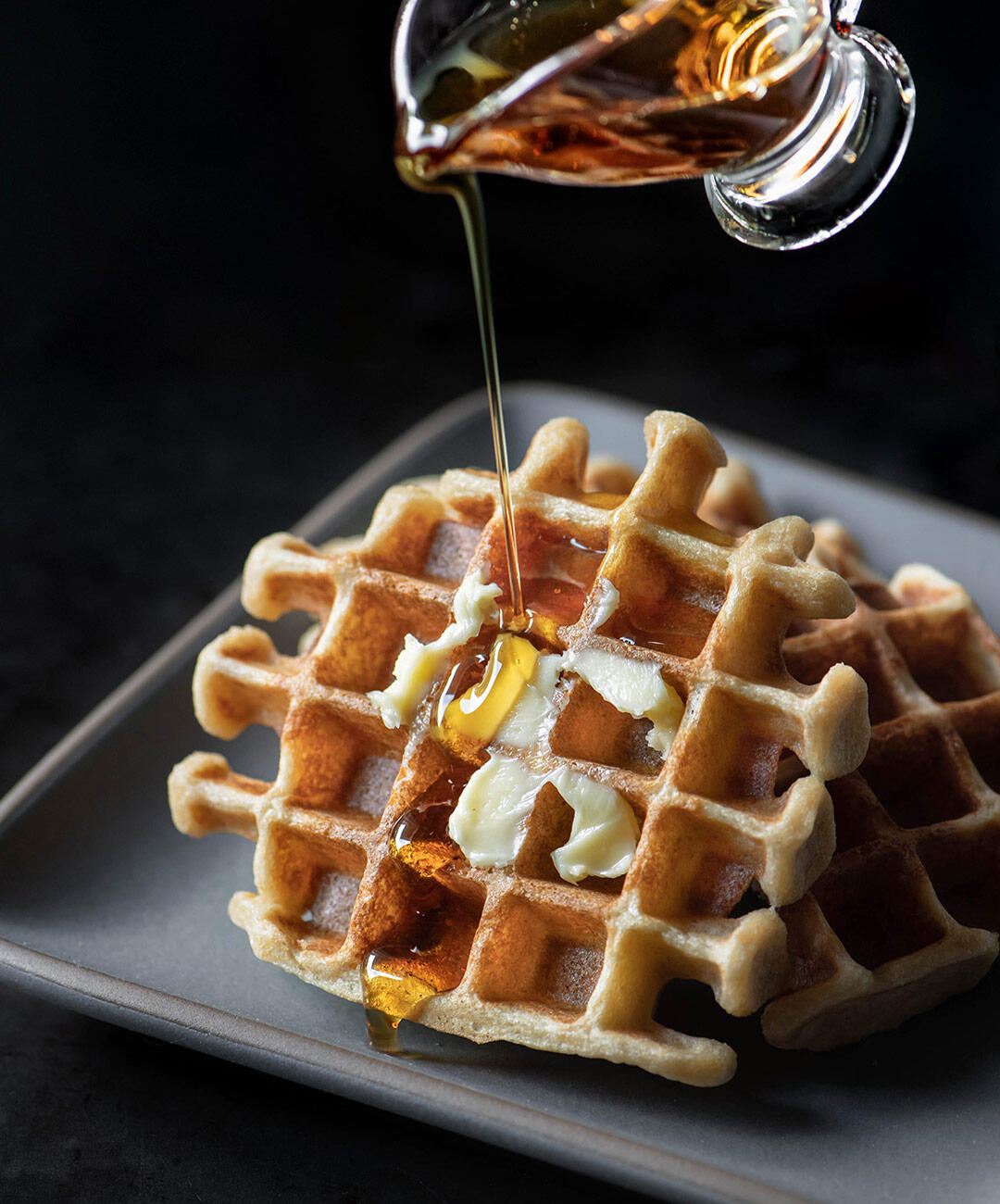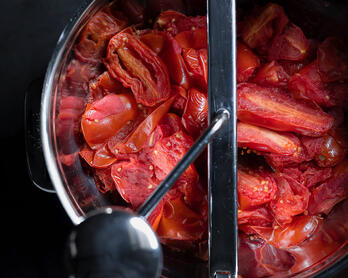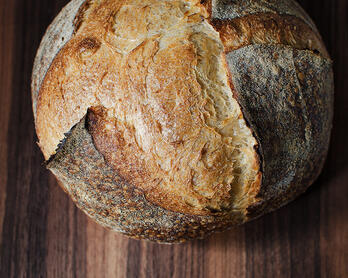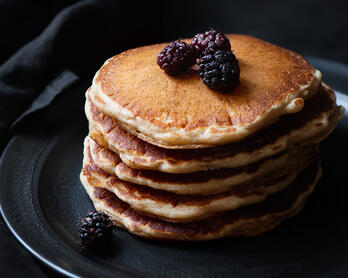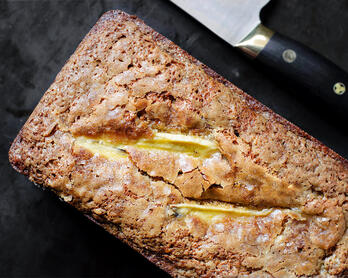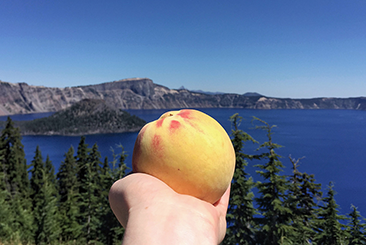Overnight Sourdough Waffles
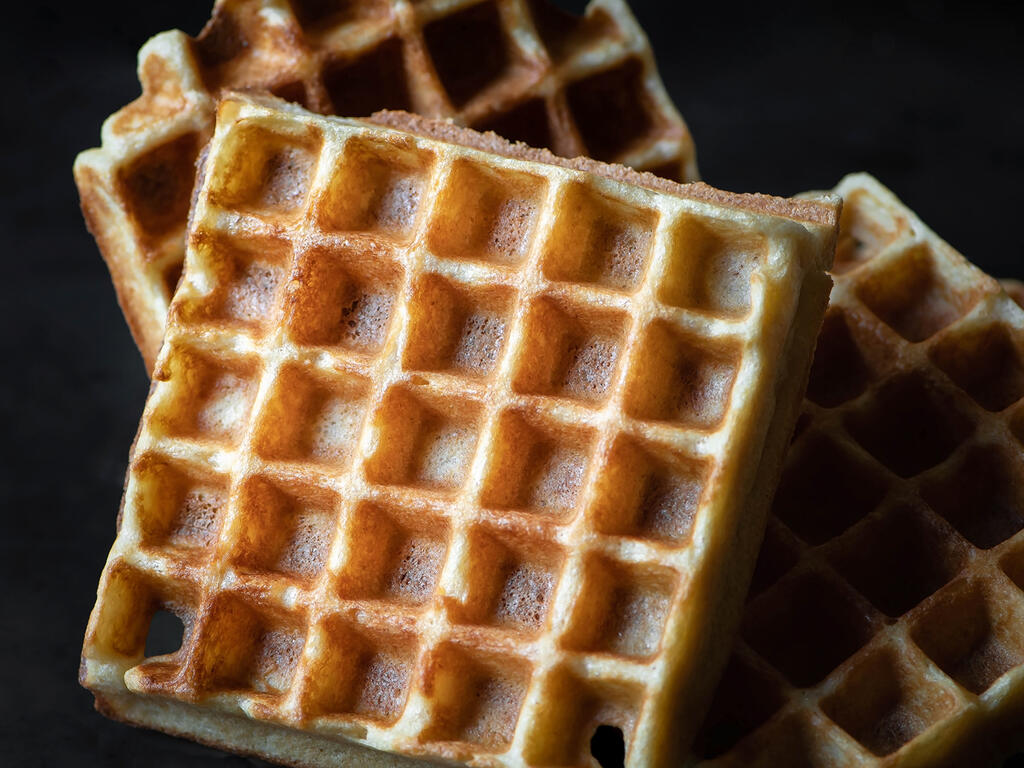
RECIPE UPDATED 3/20/2024
I started making sourdough pancakes a couple weekends ago when a sudden craving for waffles hijacked my brain. Since the pancakes were already a work in progress, I flipped through a few cookbooks to see if it was possible to transition the ingredients. Nancy Silverton's "Overnight Sourdough Waffles" in Breads from the La Brea Bakery called for 9 ounces of ripe starter which happened to be the exact amount I had already prepared. The food moons were aligned.
These waffles are so satisfying -- buttery yet crisp with the perfect structure to handle a healthy drizzle of syrup. The nutty sweetness of the whole grains and slight acidity from the sourdough starter lend a wonderful depth of flavor. In terms of adjustments, I swapped out half of the white flour for whole grain and increased the hydration accordingly. Detailed instructions and temperature notes are included in the post. If you don't have a sourdough starter, my post How to Build and Maintain a Sourdough Starter can help. If you're worried about the maintenance involved with a starter, check out Dave Miller's Sourdough Starter Maintenance which reduces feedings and minimizes waste. The joy of food pet ownership can be yours.
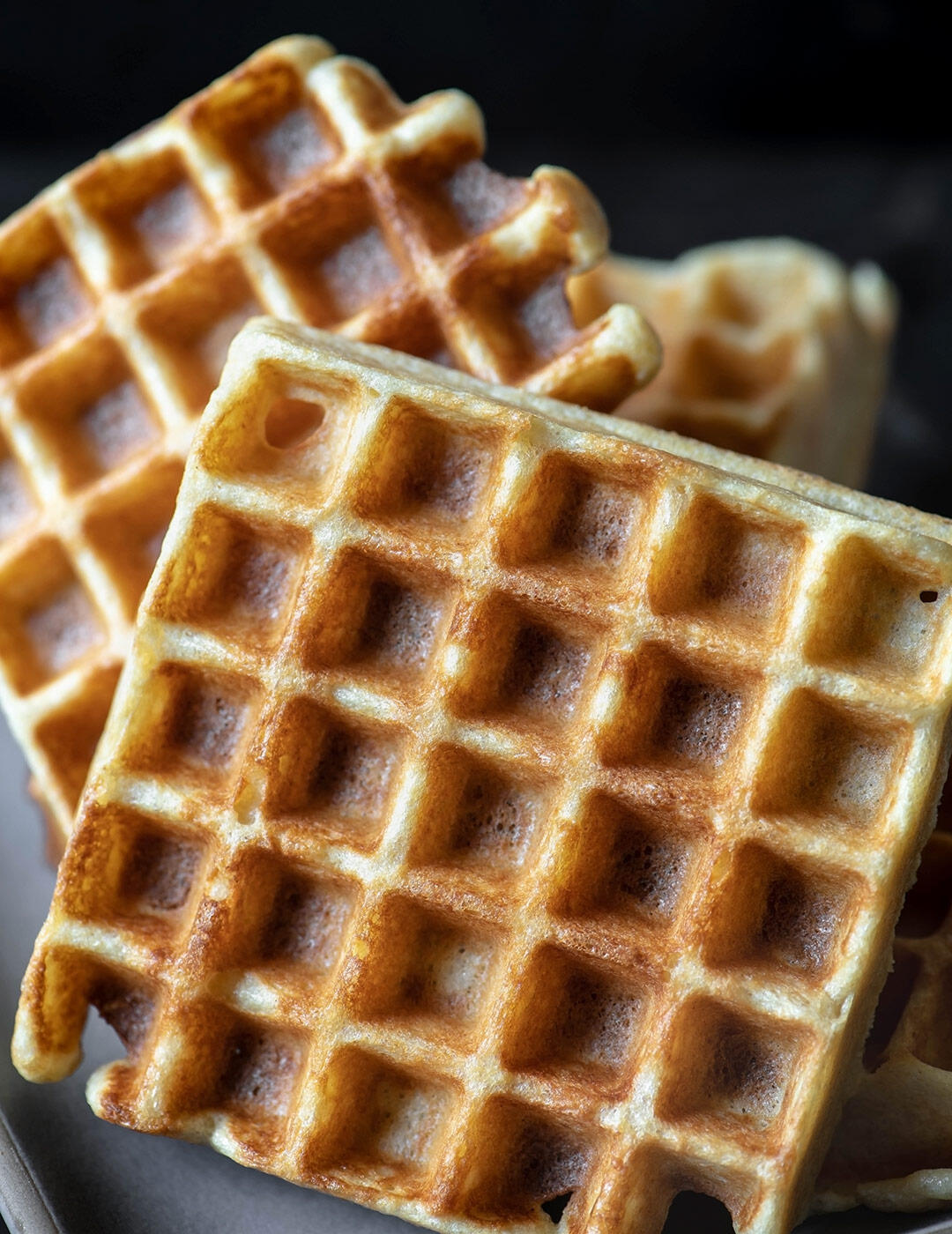
Level Up
I don't use whole wheat because it's healthy though the nutritional benefits are appreciated. I substitute quality whole grains in as many recipes as possible for the same reason that I prefer peaches and tomatoes from the farmers market over the grocery store. They're just more delicious.
I'm not disparaging roller-milled flour since it has a place in the pantry, but cooking traditions (American at least) seem to have lost their way when it comes to treating flour like a flavor contributor and not just a vehicle or binding agent. Examples of food that taste exponentially better with whole grains include pasta, brownies, pie dough, waffles, pancakes, quick breads of all kinds, cookies, biscuits, sourdough...there are many more. I would wager you won't want to make pancakes or waffles with 100% white flour again after using a quality whole grain like Sonora. Also, the "I don't like whole wheat" folks in your household will never know. On the contrary, they'll high five you for being the master of breakfast.
When buying whole wheat, consider the ingredient in the same way you would consider a tomato. Is it fresh? Is it a delicious variety? Has it been handled (or milled) properly? All of these factors matter. Low quality or old wheat flour can be bitter so look at the source, the expiration or mill date, and learn about the flavor profile. A few of the places I source flour from are listed under "Farmers | Artisans" and I also put together a list that covers the United States here.
Original vs. Adapted
Flour
As mentioned in the intro, I swapped out half of the white flour for whole grain Sonora. I didn't go all in with the whole wheat because whole grains can add a chewier texture where crispness may be desired. I did experiment with 100% whole grain waffles and enjoyed them but the texture wasn't quite right.
Refrigeration
The recipe in Breads from the La Brea Bakery calls for leaving the batter out at room temperature overnight. With a high percentage of whole grains and 100%+ inoculation, I felt the mixture would be too active to sit out that long. Inoculation is the ratio of sourdough starter to fresh flour. I refrigerate the batter overnight and bookend that cold nap with a room-temperature resting period on Day 1 and Day 2.
Milk, Baking Soda, Vanilla
I increased the milk by 2 ounces to account for the whole grains, increased the baking soda by 1/4 teaspoon to 1/2 teaspoon, and added 1/4 teaspoon vanilla. Minor tweaks that rolled over from my sourdough pancake recipe.
Egg Whites
UPDATE I recently removed this whipping step to streamline the process and can't tell the difference. If you properly ferment the batter the waffles will have a great texture. I whipped the egg whites and then folded them into the batter shortly before baking the waffles. This is a technique picked up from Cook's Illustrated that helps lighten the texture.

Tools
My Favorite Cooking Tools spotlights the kitchen equipment I have owned and used for years.
Farmers | Artisans
I make an effort to source my food from California artisans with a special focus on the Santa Monica Farmers Market. Below is a list of the folks who contributed to this dish.
- Tehachapi Heritage Grain Project // Sonora Wheat Berries
- Grist & Toll // Milled Sonora Wheat
- Hayden Mills // Sonora Wheat Berries or Flour
- Central Milling (Sonoma) // Organic Beehive All-Purpose Flour
- Omma's Garden, Apricot Lane Farms, Schaner Farms // Eggs
Ingredients (Adapted from Breads from the La Brea Bakery - 4 to 5 servings)
Day 1
- 115 grams / 4 ounces (1/2 cup) salted butter Note: I'm partial to a good contrast of salty and sweet. If you're sensitive to sodium, unsalted will work fine but I'd recommend using salted butter when serving.
- 255 grams / 9 ounces ripe 50% all-purpose/50% Sonora whole grain starter at 100% hydration
- 287 grams / 10 ounces 2% milk Note: I opt out of whole milk for these waffles since they're already plenty rich. I don't imagine whole milk would be a problem if that's what you have.
- 2 eggs (110 grams / ~ 4 ounces out of shell)
- 1/4 teaspoon vanilla extract
- 86 grams / 3 ounces whole grain Sonora
- 86 grams / 3 ounces Central Milling Organic Beehive
- 3 grams / 1/2 teaspoon baking soda
- 15 grams / 1 packed tablespoon brown sugar
- 4 grams / 1 teaspoon cane sugar
- 2.8 grams / 1 teaspoon flake-style salt
Day 2
- Syrup for serving
- Salted butter for serving
Instructions
Day 1
- Melt the butter and set aside to cool for about 5 minutes before adding to the batter. The target temperature is ~100°F.
- Combine the ripe sourdough starter and milk then stir to combine. Stir a few times more to distribute and dissolve the starter -- this may take several minutes.
- Combine the eggs with the vanilla, whisk lightly, then add to the milk.
- Sift together the flours, baking soda, sugars, and salt, breaking up any brown sugar bits. Dump any bran flakes and salt back into the flour mixture and whisk to combine.
- In two additions, fold the flour mixture into the milk mixture. Stop once there isn't any dry flour so as to avoid overmixing.
- Add the cooled butter to the bowl and stir until just combined.
- Cover the bowl with a reusable plastic cover and leave out at room temperature for 45 minutes to an hour.
- Transfer to the refrigerator for an overnight nap.
Day 2
- Remove the batter from the refrigerator, give a gentle stir to ensure everything is incorporated, then let it rest for an hour.
- Fill a deep pan with warm water (~95°F) and place the bowl with the batter directly in the pan. After about an hour the temperature of the batter will be 70 to 75°F and will look nicely fermented.
- Preheat the waffle iron. Note: The All-Clad waffle maker setting for this recipe is 3.75.
- For the All-Clad waffle maker, I add a half cup of batter to each square. The consistency of the batter is somewhere between plopping and pouring -- "thick and elastic" is how Nancy Silverton describes it.
- Bake for 4 to 6 minutes until deep golden brown.
- Serve immediately or briefly keep warm on a wire rack in a 175°F oven.
Reheating
Waffles reheat beautifully. Once cool, wrap and seal well then freeze. To reheat, I go the fast route and defrost in the microwave until just barely warmed and then pop them in the toaster. Top with a little butter and jam (or syrup) -- fantastic.
Newsletter
Subscribe at the bottom of this page for the Chic Eats roundup. It includes new and updated recipes along with a grab bag of unique content that was interesting enough to share around the dinner table.
